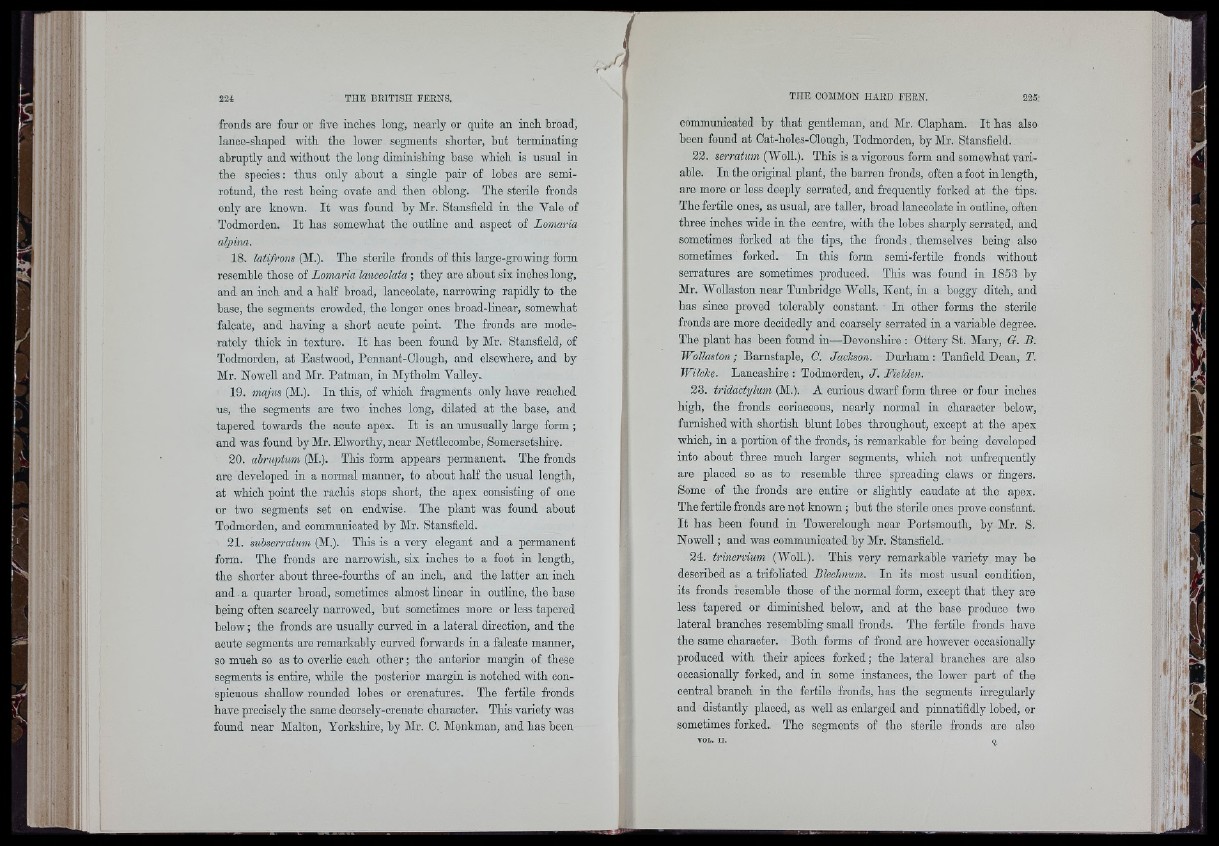
fronds aro four or five inohes long, nearly or quite an inch broad,
lanoo-shapod with the lower segments shorter, but terminating
abruptly and without the long diminishing base which is usual in
the species; thus only about a single pair of lobes are semirotund,
tho rest being ovate and then oblong. Tbe sterile fronds
only are known. It was found by Mr. Stansfield in the Vale of
Todmorden. It has somewhat the outline and aspect of Lomaría
alpina.
18. latifrom (M.). The sterile fronds of this large-growing form
resemble those of Lomaría lanceolata ; they are about six inches long,
and an inch and a half broad, lanceolate, narrowing rapidly to the
base, the segments crowded, the longer ones broad-linear, somewhat
falcate, and having a short acute point. The fronds are moderately
thick in texture. It has been found by Mr. Stansfield, of
Todmorden, at Eastwood, Pennant-Clough, and elsewhere, and by
Mr. NowcU and Mr. Patinan, in Mytholm Valley.
19. majus (M.). In this, of which fragments only have reached
us, the segments are two inches long, dilated at the base, and
tapered towards the acute apex. It is an unusually large form ;
and was found by Mr. Elworthy, near Nettlecombe, Somersetshire.
20. abruptum (M.). This form appears permanent. The fronds
are developed in a normal manner, to about half the usual length,
at which point the rachis stops short, the apex consisting of ono
or two segments set on endwise. The plant was found about
Todmorden, and oommnnicated by Mr. Stansfield.
21. subserratum (M.). This is a very elegant and a permanent
form. The fronds are narrowish, six inches to a foot in length,
the shorter about three-fourths of an inch, and the latter an inch
and a quarter broad, sometimes almost linear in outline, the base
hoing often scarcely narrowed, hut sometimes more or less tapered
below; the fronds are usually curved in a lateral direction, and the
acute segments are remarkably curved forwards in a falcate manner,
so mueh so as to overlie each other; the anterior margin of these
segments is entire, while the posterior margin is notched with conspicuous
shallow rounded lohes or crenatures. The fertile fronds
have precisely the same deorsely-orenate character. This variety was
found near Malton, Yorkshire, by Mr. 0. Monkman, and has been
communicated by that gentleman, and Mr. Clapham. It has also
been found at Cat-holes-Clough, Todmorden, by Mr. Stansfield.
22. serratum (Woll.). This is a vigorous form and somewhat variable.
In the original plant, the barren fronds, often a foot in length,
are more or less deeply serrated, and frequently forked at the tips.
Tho fertile ones, as usual, are taller, broad lanceolate in outline, often
three inches wide in the centre, with the lobes sharply serrated, and
sometimes forked at the tips, the fronds. themselves being also
sometimes forked. In this form scmi-fertile fronds without
serratures are sometimes produced. This was found in 1863 by
Mr. WoUaston near Tunbridge Wells, Kent, in a boggy ditch, and
has since proved tolerably constant. In other forms the sterile
fronds are more decidedly and coarsely serrated in a variable degree.
The plant has been found in—Devonshire : Ottery St. Mary, G. B.
Wollaston; Barnstaple, C. Jackson. Durham: Tanfiold Dean, T.
Wilcke. Lancashire : Todmorden, J. Fielden.
23. tridactylum (M.). A curious dwarf form three or four inches
high, the fronds coriaceous, nearly normal in character helow,
furnished with shortish blunt lobes throughout, except at tho apex
which, in a portion of the fronds, is remarkable for being developed
into about three much larger segments, which not unfrequently
are placed so as to resemble throe spreading claws or fingers.
Some of the fronds are entire or sUghtly caudate at the apex.
The fertUe fronds are not known ; hut the sterile ones prove constant.
It has been found in Towerolough near Portsmouth, by Mr. S.
Nowell; and was oommunioated by Mr. Stansfield.
24. trinervium (Woll). This very remarkable variety may he
described as a trifoliated Blechnum. In its most usual condition,
its fronds resemble those of the normal form, except that they are
less tapered or diminished below, aud at tbe base produce two
lateral branches resembling small fronds. The fertile fronds have
the same character. Both forms of frond are however occasionally
produced with their apices forked; the lateral branches are also
occasionaUy forked, and in some instances, the lower part of the
central branch in the fertile fronds, has the segments irregularly
and distantly placed, as well as enlarged and pinnatifidly lobed, or
sometimes forked. The segments of the sterUe fronds are also
1 .'(I
7 ■}?
"11!
nilH
fffl, P jt'1